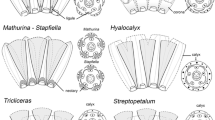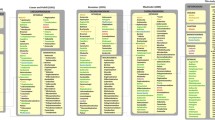Abstract
This insight is perhaps nowhere more appropriate than for a number of plant families, several of which are discussed in this book (see Chapters 10 and 11), that are the focus of extraordinarily detailed, multidisciplinary biosystematic studies. The Onagraceae, comprising seven tribes, 16 genera, and approximately 650 species (Raven, 1988), is undoubtedly one of the most thoroughly examined angiosperm families of moderate size (Raven, 1979, Raven, 1988; Sytsma and Smith, 1988). Abundant and detailed biosystematic information exists for cytology, breeding systems, morphology, vegetative and floral anatomy, and flavonoid chemistry (see the review in Raven, 1988). More recent systematic studies have used proteins and formal cladistic analyses (Gottlieb, 1986, Gottlieb, 1988; Crisci and Berry, 1990). Given the wealth of information from traditional and more recent systematic approaches, molecular phylogenetic analyses in the Onagraceae are especially applicable and justified in order to place other data bases in a more accurate or detailed phylogenetic context.
Access this chapter
Tax calculation will be finalised at checkout
Purchases are for personal use only
Preview
Unable to display preview. Download preview PDF.
Similar content being viewed by others
References
Allan, H.H. (1927) Illustrations of wild hybrids in the New Zealand flora V. Genetica 9, 499–514.
Allan, H.H. (1928) New Zealand Trees and Shrubs and How to Identify Them, Whitcombe and Tombs, Auckland.
Arroyo, M.T., and Raven, P.H. (1975) The evolution of subdioecy in morphologically gynodioecious species of Fuchsia sect. Encliandra (Onagraceae). Evolution 29, 500–511.
Averett, J.E., Hahn, W.J., Berry, P.E., and Raven, P.H. (1986) Flavonoids and flavonoid evolution in Fuchsia (Onagraceae). Amer. J. Bot. 73, 1525–1534.
Averett, J.E., and Raven, P.H. (1984) Flavonoids of Onagraceae. Ann. Missouri Bot. Gard. 71, 30–34.
Berry, P.E. (1982) The systematics and evolution of Fuchsia sect. Fuchsia (Onagraceae). Ann. Missouri Bot. Gard. 69, 1–198.
Berry, P.E., Stein, B.A., Carlquist, S., and Nowicke, J.W. (1988) Fuchsiapachyrrhiza (Onagraceae), a tuberous new species and section of Fuchsia from western Peru. Syst. Bot. 13, 483–492.
Berry, P.E., Skvarla, J.J., Partridge, A.D., and MacPhail, M.K. (1990) Fuchsia pollen from the Tertiary of Australia. Austr. Syst. Bot., submitted.
Breedlove, D.E. (1969) The systematics of Fuchsia sect. Encliandra (Onagraceae). Univ. Calif. Publ. Bot. 53, 1–69.
Breedlove, D.E., Berry, P.E., and Raven, P.H. (1982) The Mexican and Central American species of Fuchsia (Onagraceae) except for sect. Encliandra. Ann. Missouri Bot. Gard. 69, 209–234.
Crisci, J.V., and Berry, P.E. (1990) A cladistic analysis of the Australasian and Pacific species of Fuchsia (Onagraceae). Ann. Missouri Bot. Gard. 77, 517–522.
Daghlian, C.P., Skvarla, J.J., Pocknall, D., and Raven, P.H. (1985) Fuchsia pollen from the early Miocene of New Zealand. Amer. J. Bot. 72, 1039–1047.
Davis, W.S. (1970) The systematics of Clarkia bottae, C. cylindrica, and a related species, C. rostrata. Brittonia 22, 270–284.
Dymond, J. (1975) K-Ar ages of Tahiti and Moorea, Society Islands, and implications for the hot-spot model. Geology 3, 236–240.
Godley, E.J. (1955) Breeding systems in New Zealand plants. 1. Fuchsia. Ann. Bott. 19, 549–559.
Godley, E.J. (1963) Breeding systems in New Zealand plants. 2. Genetics of the sex forms in Fuchsia procumbens. NZ J. Bot. 1, 48–52.
Gottlieb, L.D. (1973) Enzyme differentiation and phylogeny in Clarkia franciscana, C. rubicunda and C. amoena. Evolution 27, 205–214.
Gottlieb, L.D. (1974a) Genetic confirmation of the origin of Clarkia lingulata. Evolution 28, 244–250.
Gottlieb, L.D. (1974b) Gene duplication and fixed heterozygosity for alcohol dehydrogenase in the diploid plant Clarkia franciscana. Proc. Natl. Acad. Sci. USA 71, 1816–818.
Gottlieb, L.D. (1977) Evidence for duplication and divergence of the structural gene for phosphoglucose isomerase in diploid species of Clarkia. Genetics 86, 289–307.
Gottlieb, L.D. (1981) Electrophoretic evidence and plant populations. Progress in Phyto-chem. 7, 1–46.
Gottlieb, L.D. (1982) Conservation and duplication of isozymes in plants. Science 216, 373–380.
Gottlieb, L.D. (1983) Isozyme number and phylogeny. In: Proteins and Nucleic Acids in Plant Systematics (eds. U. Jensen and D.E. Fairbrothers), Springer-Verlag, Berlin, pp. 209–221.
Gottlieb, L.D. (1986) Genetic differentiation, speciation, and phylogeny in Clarkia (Onagraceae). In: Modern Aspects of Species (eds. K. Iwatsuki, P.H. Raven, and W.J. Bock), University of Tokyo Press, Tokyo, pp. 145-160.
Gottlieb, L.D. (1988a) In: Plant Evolutionary Biology (eds. L.D. Gottlieb and S.K. Jain), Chapman and Hall, London, p. 153.
Gottlieb, L.D. (1988b) Towards molecular genetics in Clarkia: gene duplications and molecular characterization of PGI genes. Ann. Missouri Bot. Gard. 75, 1169–1179.
Gottlieb, L.D. (1989) Floral pigmentation patterns in Clarkia (Onagraceae). Madroño 36, 1–8.
Gottlieb, L.D., and Ford, V.S. (1988) Genetic studies of the pattern of floral pigmentation in Clarkia gracilis. Heredity 60, 237–246.
Gottlieb, L.D., and Jain, S.K. (eds.) (1988) Plant Evolutionary Biology, Chapman and Hall, London.
Gottlieb, L.D., and Pilz, G. (1976) Genetic similarity between Gaura longifolia and its obligately outcrossing derivative G. demareei. Syst. Bot. 1, 181–187.
Gottlieb, L.D., and Weeden, N.F. (1979) Gene duplication and phylogeny in Clarkia. Evolution 33, 1024–1039.
Hillis, D.M. (1987) Molecular versus morphological approaches to systematics. Ann. Rev. Ecol. Syst. 18, 23–42.
Holsinger, K.E., and Gottlieb, L.D. (1988) Isozyme variability in the tetraploid Clarkia gracilis (Onagraceae) and its diploid relatives. Syst. Bot. 13, 1–6.
Jansen, R.K., and Palmer, J.D. (1988) Phylogenetic implications of chloroplast DNA restriction site variation in the Mutisieae (Asteraceae). Amer. J. Bot. 75, 753–766.
Kurabayashi, M., Lewis, H., and Raven, P.H. (1962) A comparative study of mitosis in Onagraceae. Amer. J. Bot. 49, 1003–1026.
Lewis, H. (1953a) The mechanism of evolution in the genus Clarkia. Evolution 7, 1–20.
Lewis, H. (1953b) Chromosome phylogeny and habitat preference in Clarkia. Evolution 7, 102–109.
Lewis, H. (1962) Catastrophic selection as a factor in speciation. Evolution 16, 257-271.
Lewis, H. (1980) The mode of evolution in Clarkia. Symposium paper presented at International Congress Systematics and Evolutionary Biol. II, Vancouver, BC.
Lewis, H., and Lewis, M.E. (1955) The genus Clarkia. Univ. Calif. Puhl. Bot. 20, 241–392.
Lewis, H., and Raven, P.H. (1958) Rapid evolution in Clarkia. Evolution 12, 319–336.
Lewis, H., and Roberts, M.R. (1956) The origin of Clarkia lingulata. Evolution 10, 126–138.
MacSwain, J.W., Raven, P.H., and Thorp, R.W. (1973) Comparative behavior of bees and Onagraceae. IV. Clarkia bees of the Western United States. Univ. Calif. Publ. Entomol. 70, 1–80.
Narayan, R.K.J. (1988) Evolutionary significance of DNA variation in plants. Evol. Trends Plants 2, 121–130.
Nowicke, J.W., Skvarla, J.J., Raven, P.H., and Berry, P.E. (1984) A palynological study of the genus Fuchsia (Onagraceae). Ann. Missouri Bot. Gard. 71, 35–91.
Odrzykoski, I.J., and Gottlieb, L.D. (1984) Duplications of genes coding 6-phosphogluconate dehydrogenase in Clarkia (Onagraceae) and their phylogenetic implications. Syst. Bot. 9, 479–489.
Pichersky, E., and Gottlieb, L.D. (1983) Evidence for duplication of the structural genes coding plastid and cytosolic isozymes of triose phosphate isomerase in diploid species of Clarkia. Genetics 105, 421–436.
Pocknall, D.T., and Mildenhall, D.C. (1984) Late Oligocene—early Miocene spores and pollen from Southland, New Zealand. NZ Geol. Surv. Paleontol. Bull. 51, 1–66.
Raven, P.H. (1979) A survey of reproductive biology in Onagraceae. NZJ. Bot. 17, 575–593.
Raven, P.H. (1988) Onagraceae as a model of plant evolution. In: Plant Evolutionary Biology (eds L.D. Gottlieb and S.K. Jain), Chapman and Hall, London, pp. 85–107.
Raven, P.H., and Axelrod, D.I. (1974) Angiosperm biogeography and past continental movements. Ann. Missouri Bot. Gard. 61, 539–673.
Raven, P.H., and Raven, T.E. (1976) The genus Epilobium in Australasia: a systematic and evolutionary study. NZ Dept. Sei. Ind. Res. Bull. 216, 1–321.
Rothrock, J.T. (1864) Synopsis of North American Gaurineae. Proc. Amer. Acad. 6, 347–354.
Seavey, S.R. (1977) Segregation of translocated chromosomes in Epilobium and Boisduvalia hybrids (Onagraceae). Syst. Bot. 2, 109–121.
Skvarla, J.J., Raven, P.H., Chissoe, W.F., and Sharp, M. (1978) An ultrastructural study of viscin threads in Onagraceae pollen. Pollen et Spores 20, 5–143.
Small, E. (1971) The systematics of Clarkia, section Myxocarpa. Canad. J. Bot. 49, 1211–1217.
Small, E. (1972a) Adaptation in Clarkia, section Myxocarpa. Ecology 53, 808–818.
Small, E. (1972b) Tempo of adaptive change during the rapid evolution of chromosomal isolates. Taxon 21, 559–565.
Small, E., Bassett, I.J., Crompton, C.W., and Lewis, H. (1971) Pollen phylogeny in Clarkia. Taxon 20, 739–746.
Smith, R.L., and Sytsma, K.J. (1990) Evolution of Populus nigra (sect. Aigeiros): introgressive hybridization and the chloroplast contribution of Populus alba (sect. Populus). Amer. J. Bot. 77, 1176–1187.
Smith-Huerta, N.L. (1986) Isozymic diversity in three allotetraploid Clarkia species and their putative diploid progenitors. J. Hered. 77, 349–354.
Soltis, P.S. (1986) Anthocyanidin variation in Clarkia. Biochem. Syst. Ecol. 14, 487–489.
Soltis, P.S., Soltis, D.E., and Gottlieb, L.D. (1987) Phosphoglucomutase gene duplications in Clarkia (Onagraceae) and their phylogenetic implications. Evolution 41, 667–671.
Sytsma, K.J. (1990) DNA and morphology: inference of plant phylogeny. Trends Ecol. Evol. 5, 104–110.
Sytsma, K.J., and Gottlieb, L.D. (1986a) Chloroplast DNA evidence for the origin of the genus Heterogaura from a species of Clarkia (Onagraceae). Proc. Natl. Acad. Sci. USA 83, 5554–5557.
Sytsma, K.J., and Gottlieb, L.D. (1986b) Chloroplast DNA evolution and phylogenetic relationships in Clarkia sect. Peripetasma (Onagraceae). Evolution 40, 1248–1261.
Sytsma, K.J., and Smith, J.F. (1988) DNA and morphology: comparisons in the Onagraceae. Ann. Missouri Bot. Gard. 75, 1217–1237.
Sytsma, K.J., Smith, J.F., and Berry, P.E. (1991) The use of chloroplast DNA to assess biogeography and evolution of morphology, breeding systems, flavonoids, and chloroplast DNA in Fuchsia sect. Skinnera (Onagraceae). Syst. Bot. 16, 257–269.
Sytsma, K.J., Smith, J.F., and Gottlieb, L.D. (1990) Phylogenetics in Clarkia (Onagraceae): restriction site mapping of chloroplast DNA. Syst. Bot. 15, 280–295.
Tobe, H., and Raven, P.H. (1985) The histogenesis and evolution of integuments in Onagraceae. Ann. Missouri Bot. Gard. 72, 451–468.
Tobe, H., and Raven, P.H. (1986) Evolution of polysporangiate anthers in Onagraceae. Amer. J. Bot. 73, 475–488.
Vasek, F.C. (1958) The relationships of Clarkia exilis to Clarkia unguiculata. Amer. J. Bot. 45, 150–162.
Williams, CA., and Garnock-Jones, P.J. (1986) Leaf flavonoids and other phenolic glycosides and the taxonomy and phylogeny of Fuchsia sect. Skinnera (Onagraceae). Phytochem. 25, 2547–2549.
Editor information
Rights and permissions
Copyright information
© 1992 Springer Science+Business Media Dordrecht
About this chapter
Cite this chapter
Sytsma, K.J., Smith, J.F. (1992). Molecular Systematics of Onagraceae: Examples from Clarkia and Fuchsia . In: Soltis, P.S., Soltis, D.E., Doyle, J.J. (eds) Molecular Systematics of Plants. Springer, Boston, MA. https://doi.org/10.1007/978-1-4615-3276-7_13
Download citation
DOI: https://doi.org/10.1007/978-1-4615-3276-7_13
Publisher Name: Springer, Boston, MA
Print ISBN: 978-0-412-02241-8
Online ISBN: 978-1-4615-3276-7
eBook Packages: Springer Book Archive




